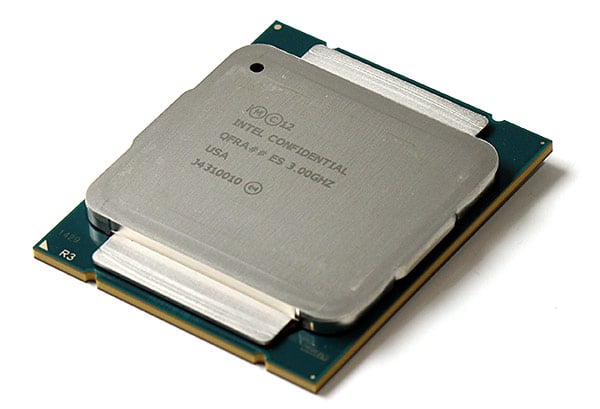Haswell-E Debuts: Intel Core i7-5960X Processor Review
Introduction and Specifications
 We have been eagerly anticipating the release of processors based on Intel’s Haswell-E microarchitecture for quite some time. After about three years of incremental performance improvements at the ultra-high end, as Sandy Bridge-E was eventually replaced by similarly clocked Ivy Bridge-E based processors, the rumored specs of Haswell-E were enticing. Unlike Sandy Bridge-E and Ivy Bridge-E, which maxed out at 6 cores (12 threads) with desktops variants, Haswell-E would be an 8-core machine (16 threads), featuring execution units based on Intel’s latest microarchitecture. Assuming similar clocks, the speculation was that the additional cores and newer microarchitecture would translate into significant performance and efficiency gains, which would be welcome improvements to say the least.
We have been eagerly anticipating the release of processors based on Intel’s Haswell-E microarchitecture for quite some time. After about three years of incremental performance improvements at the ultra-high end, as Sandy Bridge-E was eventually replaced by similarly clocked Ivy Bridge-E based processors, the rumored specs of Haswell-E were enticing. Unlike Sandy Bridge-E and Ivy Bridge-E, which maxed out at 6 cores (12 threads) with desktops variants, Haswell-E would be an 8-core machine (16 threads), featuring execution units based on Intel’s latest microarchitecture. Assuming similar clocks, the speculation was that the additional cores and newer microarchitecture would translate into significant performance and efficiency gains, which would be welcome improvements to say the least.
Well, we can stop speculating now, because Haswell-E is here. Today, Intel is officially launching the Core i7-5960X Extreme Edition and we’ve had the opportunity to take it for a spin in an array of brand new X99-based motherboards. The Core i7-5960X Extreme Edition is Intel’s latest desktop flagship, but the company is launching a couple of other lower-end Haswell-E-based processors as well, though using the term “lower-end” is probably a little misleading, considering the chips feature 6-cores and relatively high clocks.
We’ll dig in a little deeper, discuss Intel’s full Haswell-E line-up, and evaluate performance a little later. For now, let’s get some particulars out of the way and check out the brand-new Core i7-5960X’s features and specifications...
|
|
Eight Core Processing: Runs 8 independent processor cores in one physical package Base Processor Frequency: 3.0 GHz Massive PCI Express Bandwidth: 40 lanes of PCIe supported through the processor Intel Turbo Boost Technology 2.0: Dynamically increases the processor frequency up to 3.5GHz when applications demand more performance. Speed when you need it, energy efficiency when you don’t. Intel Hyper-Threading Technology: 16 threads provide unprecedented processing capability for better multi-tasking and threaded applications. Do more with less wait time. Intel Smart Cache: Up to 20MB of shared cached allows faster access to your data by enabling dynamic and efficient allocation of the cache to match the needs of each core significantly reducing latency to frequently used data and improving performance. Overclocking Enabled: Core (Turbo) and DDR4 ratios are unlocked for ease of overclocking Integrated Memory Controller: Supports 4 channels of DDR4-21330 memory with 1 DIMM per channel. Support for XMP memory. |

Intel LGA 2011 v3 Haswell-E Processor, Top and Bottom

One of our engineering samples...
Although it has the same number of pads (2011) as previous-gen Ivy Bridge-E and Sandy Bridge-E processors, Haswell-E based processors like the Core i7-5960X will require new motherboards equipped with LGA 2011 v3 sockets and support for DDR4 memory. We should mention, however, that CPU coolers designed for the original LGA 2011 sockets will work perfectly fine on LGA 2011 v3 sockets.
The Core i7-5960X pictured here also has a different integrated heat-spreader design than Ivy Bridge-E and Sandy Bridge-E processors and the capacitor layout on the underside of the chip is different as well.






